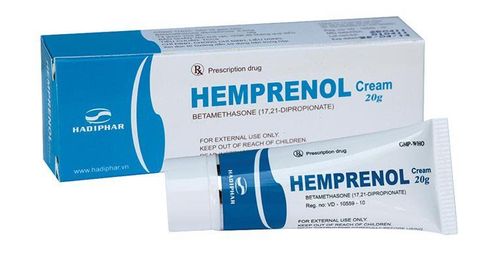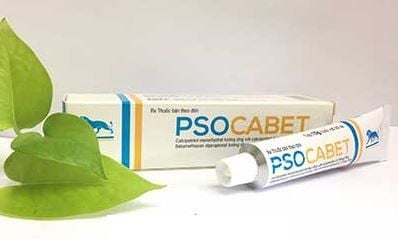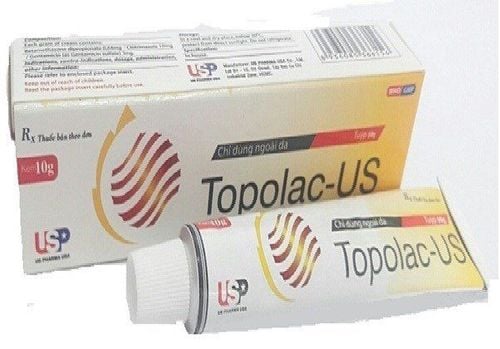This is an automatically translated article.
Betanic medicine contains the main active ingredient is Betamethasone with a concentration of 0.5mg and other excipients in a sufficient amount. This is a drug of a group of hormones, hormones, used in the treatment of rheumatism, acute rheumatism, asthma, allergic rhinitis, ...
1. What is Betanic drug?
What is Betanic drug? Betanic medicine contains the main active ingredient is Betamethasone with a concentration of 0.5mg and other excipients in a sufficient amount. This is a hormone, hormonal drug, used in the treatment of rheumatic diseases, acute rheumatism, asthma, allergic rhinitis,...
Betanic drug is prepared in the form of tablets, suitable for use administered orally directly. Packing is a box of 5 blisters or a box of 10 blisters, each blister contains 10 tablets.
1.1. Pharmacodynamics of the active ingredient Betamethasone Active ingredient Betamethasone is a synthetic derivative of Prednisolone. Betamethasone is an adrenal corticosteroid with anti-inflammatory properties. Betamethasone has strong anti-inflammatory, anti-arthritic and anti-allergic properties, used in the treatment of disorders that have responded to corticosteroids. As a glucocorticoid, betamethasone induces extensive and varied metabolic effects and reduces the body's resistance to stimuli. Betamethasone has high glucocorticoid activity and low mineralocorticoid activity. 1.2. Pharmacokinetics of the active ingredient Betamethasone: Absorption: Betamethasone drug is easily absorbed from the gastrointestinal tract. Distribution: Betamethasone is rapidly distributed into all body tissues. This drug crosses the placenta and can be excreted in breast milk in small amounts. In the circulation, the drug Betamethasone has the ability to bind widely to plasma proteins, mainly globulin, and less to albumin. Metabolism: The main active ingredient Betamethasone is slowly metabolised, mainly in the liver but also in the kidneys and excreted in the urine. Elimination: Betamethasone is eliminated mainly in the urine. 1.3. Effects of the active ingredient Betamethasone Main active ingredient Betamethasone is a synthetic corticosteroid with very strong glucocorticoid effects, accompanied by negligible mineralocorticoid effects. Betamethasone has anti-inflammatory, anti-allergic and anti-rheumatic properties. Because of its low mineralocorticoid effect, Betamethasone is well suited in pathological conditions where the effect of water retention is detrimental. When used in high doses, betamethasone has an immunosuppressive effect.
2. What effects does Betanic have?
What does Betanic drug do? Betanic drugs are used to treat the following diseases:
Betanic drugs are used in endocrine diseases, musculoskeletal disorders, collagen disorders, skin, allergies, eye, respiratory, blood, cancer and other diseases. Other reasons have responded to corticosteroid therapy. Treatment of musculoskeletal disorders: used as an adjunct to short-term treatment of psoriasis-associated rheumatism; acute rheumatoid arthritis (in some cases low maintenance doses can be used); ankylosing spondylitis; acute and subacute bursitis; nonspecific acute synovitis; acute rheumatic diseases; leprosy and synovitis. Treatment of dermatological diseases such as vesicular dermatitis herpetiformis; severe erythema multiforme (Stevens-Johnson syndrome); exfoliative dermatitis; fungal warts; severe psoriasis; allergic eczema or chronic dermatitis and urticaria . Treatment of severe allergic reactions or failure of conventional therapies such as seasonal or persistent allergic rhinitis, nasal polyps, bronchial asthma including asthma, contact dermatitis, dermatitis allergies, neurodermatitis, drug and serum reactions.
3. Usage and dosage of Betanic
3.1. How to use Betanic Drug Betanic drug is prepared in the form of tablets, suitable for direct oral use.
3.2. Dosage of Betanic The starting dose is 0.25 - 8 mg/day depending on the specific disease. Children take a dose of 17.5 - 250 mcg/kg/day. Dosage for treatment of rheumatoid arthritis and other lesions is 1 - 2.5 mg/day, maintenance: 0.5 - 1.5 mg/day. Dosage for acute rheumatic fever is 6-8 mg/day, then reduce from 0.25 - 0.5 mg/day until the maintenance dose is reached and continue for 4 to 8 weeks. Dosage for treatment of asthma 3.5 - 4 mg/day x 1 - 2 days; then reduce the dose to 0.25 - 0.5 mg / every other day until the maintenance dose is reached. Dosage for treatment of emphysema-pulmonary fibrosis orally 2 - 3.5 mg/day (in divided doses); maintain oral 1 - 2.5 mg. Dosage for treatment of difficult-to-treat allergic rhinitis on the first day is 1.5 to 2.5 mg/day, divided into several times; then gradually reduce 0.5 mg/day until symptoms recur.
4. Undesirable effects of the drug Betanic
The adverse effects of Betanic drugs are similar to those of other corticosteroid drugs, related to dose and duration of treatment. Usually these effects are reversible or alleviated by dose reduction. In general, it is better to discontinue the drug in these cases.
Water and electrolyte disorders: salt and water retention, congestive heart failure, potassium loss, hypertension, hypokalemia. For the musculoskeletal system: muscle weakness, corticosteroid-induced myopathy, decreased muscle mass, exacerbation of myasthenia gravis, osteoporosis, vertebral depression, aseptic necrosis of the femoral and bony heads arm, pathological long bone fracture, ligament rupture. For the digestive system: gastritis with perforation or bleeding, pancreatitis, abdominal distention, ulcerative esophagitis. For the skin: slow down the wound healing process, on young skin, thin and brittle skin; petechiae and ecchymosis; facial erythema; increased sweating; changes in skin test results; allergic reactions such as atopic dermatitis, urticaria or angioedema. For the nervous system: convulsions; increased intracranial pressure with papilledema (causing pseudotumor in the brain) often after treatment; dizzy; headache pain. For the endocrine system: menstrual disorders; reduce the growth of the embryo in the uterus or the development of the baby; secondary adrenal and pituitary loss of response, especially during periods of prolonged stress or stress. For eyes: causes subcapsular cataracts, glaucoma, glaucoma or bulging eyes. Metabolic disorders: Negative nitrogen balance due to protein catabolism. Psychiatric disorders: causing increased euphoria, lightheadedness; manifestations of severe psychological impairment; personality changes or insomnia. Other undesirable effects: anaphylaxis or hypersensitivity reactions.
5. Betanic drug interactions
Betanic drug interactions may change its ability to work or increase the effects of unwanted effects. You should proactively list to your doctor or pharmacist all prescription and over-the-counter medicines, herbal products, vitamins and minerals, and health foods you are taking. used to minimize possible drug interactions.
6. Some notes when using Betanic
6.1. Contraindications of Betanic drugs: The following cases should not use Betanic drugs, specifically as follows:
People who have had or are having systemic fungal infections. People who have had a hypersensitivity reaction to Betamethasone or to other Corticosteroids or to any of the ingredients of Celestone. 6.2. Precautions when taking Betanic Herpes infected people; People with digestive diseases, such as non-specific ulcerative colitis, appendicitis, recent bowel surgery; stomach ulcers. People with diseases such as kidney failure, hypertension, osteoporosis and severe myasthenia gravis. People who are not vaccinated. Above is all information about Betanic drug, patients need to carefully read the instructions for use, consult a doctor / pharmacist before using. Absolutely do not arbitrarily buy Betanic drugs to treat diseases at home, because there may be unwanted side effects on health.
Follow Vinmec International General Hospital website to get more health, nutrition and beauty information to protect the health of yourself and your loved ones in your family.













